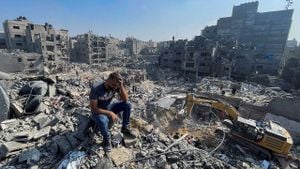Ethiopia's Oromia region has become embroiled once again in violence, as recent reports indicate the brutal killing of 48 individuals, attributed to armed rebels known as the Oromo Liberation Army (OLA). This ambush occurred last week within the North Shewa district, located just west of the capital, Addis Ababa, according to the Ethiopian Human Rights Commission (EHRC).
The EHRC, which is both state-affiliated and independent, is actively investigating these killings. Some of the victims included local officials, and several others were reported kidnapped during the ambush, signaling the volatile nature of the area. Ato Badassa, the regional head of EHRC, expressed deep concern, stating, "The situation in the area is very volatile at the moment."
The violence marks another chapter in Oromia's long-standing struggle, which has been rife with insurrections since 2018 when the OLA began its campaign. Despite attempts at peace talks, progress has stalled, amplifying the region's underlying tensions, which include political divisions and ethnic disputes. Oromia is Ethiopia's most populous region, sandwiched between various factions and historic grievances.
The conflict has seen the OLA accused of orchestrated attacks against government forces, claims which the rebel group vigorously denies. Conversely, the Ethiopian government is under fire for implementing widespread crackdowns on suspected OLA supporters, actions which activists argue only deepen the resentment felt by many within the Oromo community.
Since 2018, the OLA’s numbers have grown, reflecting their strengthening presence within the region. Yet, analysts suggest these rebels, numbering only in the thousands, lack the organizational structure and heavy weaponry needed to pose a significant threat to the government's authority.
This ambush follows the conclusion of the devastating two-year conflict centered around the Tigray region, which ended just last November. While the end of hostilities there brought some relief, multiple conflicts remain unsolved across the country, particularly affecting the Amhara region as well, hinting at a wider instability within Ethiopia.
The humanitarian consequences of such violence are dire, as communities find themselves trapped between competing armed factions, leaving families displaced and vulnerable. Organizations monitoring the situation have raised alarms about the rising tide of violence, calling for both accountability and immediate intervention.
Throughout Ethiopia, there’s increasing recognition of the need for dialogue and conflict resolution, yet persistent violence—like the sort witnessed recently—is undermining those efforts. The OLA's continued insurrection, coupled with the government’s heavy-handed response, perpetuates the discord.
Human rights agencies hope the Ethiopian government will take steps to avoid repeating the same mistakes and aggravate existing tensions. Moving forward, the international community watches closely, urging peace talks and humanitarian support to the areas affected.
Getting to the root of these conflicts requires not just military strategies, but also social and political reforms aimed at addressing the grievances of Ethiopia’s diverse ethnic groups. Immediate action is necessary to chart the path away from violence—a challenge as complicated as it is urgent.
The situation remains fluid, as investigations by the EHRC continue and communities across Oromia assess their precarious circumstances and the specter of violence lingers.



